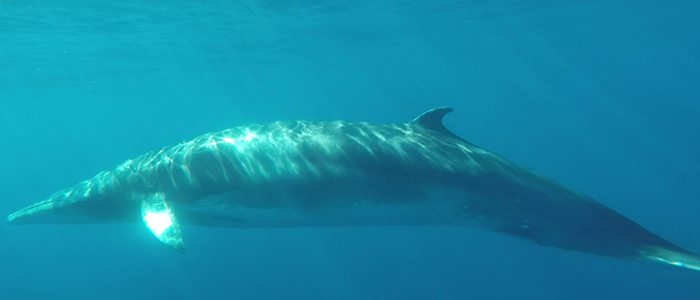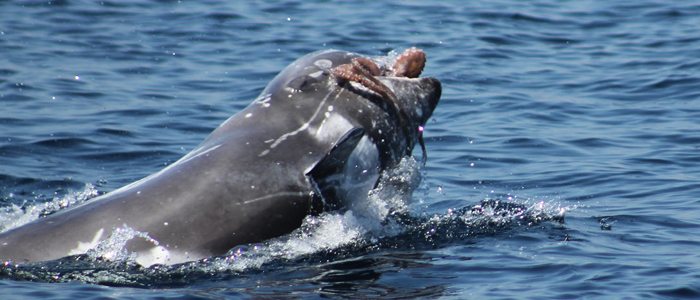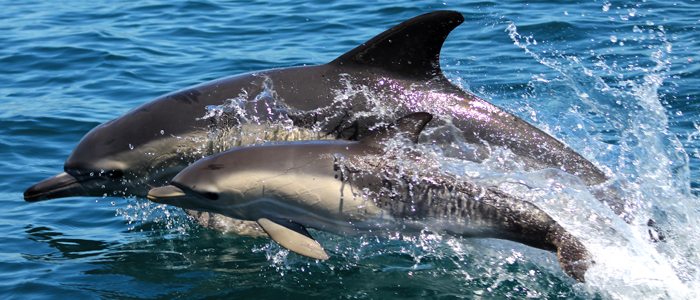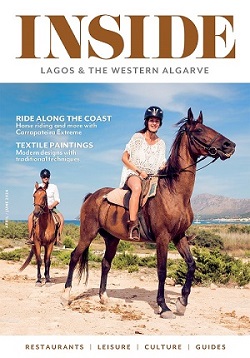Exciting new sightings of whales off the Algarve coast
Historically, whale sightings have not been widespread in the Algarve, and you would typically have to travel to the Azores or Madeira for the opportunity to see the spectacular mammals in Portuguese waters. That is why we were so excited when we received the sightings report from local Marine Biologist, tour operators Wildwatch, in Ferragudo, stating that not only did they have a fantastic result with a 98.4% success rate on their cetacean (dolphins, whales and porpoises) trips but they also spotted a record number of whales in the Algarvean waters. In 2017, Wildwatch reported 23 minke whale sightings, of one or two individuals, three fin whale sightings, all with two individuals, and one humpback whale.
With varying diets of microscopic plankton and krill to a significant diversity of fish species, this class of baleen whales does not have teeth but rather a row of filtering plates inside their mouths. They take in a mouthful of water and then push the tongue forward to force it all out through their baleen, catching any prey on the inside of the plates. “Minke whale is the more common whale that can be seen all year. They are resident in the area and up to 10 metres long, making this also the smallest whale spotted in the zone. They are occasionally moved by curiosity and approach the boats, offering excellent opportunities to admire them,” explained the founding partners of Wildwatch, Lucia and André. “When they show up, you can distinguish them by a white band on each pectoral.” They also have a small, low blow, as they start exhaling before they reach the surface, which makes spotting them more difficult.
The fin whale is the second largest whale and second largest animal in the world, and Wildwatch have spotted them passing in migration. They can grow up to 25m long and weigh an enormous 120 tonnes. When spotting them, “we look for asymmetrical colouration on their lower jaw to distinguish them, the right side is white and the left is dark grey or black,” Lucia told us. Unlike the minke, this species’ blow is very tall and can be seen from far. On one occasion, Wildwatch encountered fin whales alongside bottlenose dolphins, which must be quite a treat to watch them swim together and to see how small a 4m dolphin looks beside this peaceful giant.
Orcas are the biggest dolphin on the planet and pass the Algarve coast at least twice a year, following tuna migration routes in and out of the Mediterranean. There was a rare and fairly unusual sighting of orcas and common dolphins that looked very curious with each other. “It is actually quite unusual to see different species together,” Lucia explained. “Moreover, orcas are known as a predator of other dolphins or whales, like the common dolphins, so you can imagine how our clients reacted once we realised what we were witnessing. Thankfully, it was a friendly meeting, as the population of orcas we can see passing by our waters have a refined taste for bluefin tuna.” These massive mammals are better known as killer whales, so called not because they harm humans but because some populations in the world feed on other types of cetacea.
The company also spotted a group of pilot whales for the first time in 2017. Returning from a trip, André saw something in the distance on the surface of the water that looked like birds floating. When he went to investigate, he was surprised by a calm pod of around 30 pilot whales, including a female with a very young calf. It was a beautiful and moving experience for those lucky enough to be there.
Pilot whales, who are also among the largest members of the dolphin family, have one of the longest birth intervals of all cetaceans, between 3 to 5 years. “We do not have enough data and experience to be certain of the species ID, between short-finned or long-finned pilot whales, so we hope to see them more frequently around here,” said André.
From the selection of whales seen, last but certainly not least, a massive, solitary humpback whale was spotted around three nautical miles from the coast. This species can grow up to 17m and they have long, white pectoral fins, up to 5m in length. Famous for their complex and beautiful vocalisations, they are also known as the singing whales. They are also very acrobatic and are frequently seen breaching.
With sightings of dolphins becoming more and more talked about, we asked Lucia which species are these and why are they here: “Common bottlenose dolphins are often spotted from land and cause mixed emotions with spectators,” she said. “Many people think that the dolphins must be hungry to have come so close to the shore, but these are not offshore, oceanic bottlenose dolphins, they are in fact a coastal ecotype who is more than happy near land.” The only danger they pose to themselves is that their curious nature will get them tangled up in the busy boating lane. “Maybe due to this, the oceanic ecotype appears to be more interested in approaching our boat, and sometimes they spot us and join us before we spot them,” she explained.
The largest families in the toothed cetacean group are the dolphins. Mysterious creatures like the Risso’s dolphin, the acrobatic striped dolphin, and of course the two star species – common bottlenose dolphins, made famous by the movie Flipper, and the sociable short-beaked common dolphins – would be the obvious ones but what might surprise you is that orcas and pilot whales, which we could assume to be whales, are actually a part of this dolphin family.
Recently, there have been more sightings of the almost white-coloured Risso’s dolphins, slow swimmers feeding on octopus, cuttlefish and squid. Unfortunately, striped dolphins sightings were less frequent. In fact, Wildwatch expects to see this acrobatic, oceanic dolphin three, four, or five times a year, but last year they only saw them once.
Having a team of Marine biologists in the company is one of the reasons Wildwatch stand out, and you can book a trip with them or find out more via www.wildwatch.pt
Text: Mia Wallace
Photos: Wildwatch
















